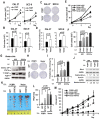PCBP1 inhibits the expression of oncogenic STAT3 isoform by targeting alternative splicing of STAT3 exon 23
- PMID: 31223278
- PMCID: PMC6567812
- DOI: 10.7150/ijbs.33103
PCBP1 inhibits the expression of oncogenic STAT3 isoform by targeting alternative splicing of STAT3 exon 23
Abstract
STAT3 plays very important roles in the initiation and development of tumors. Despite of extensive studies in repressing its activation and function via multiple ways, so far, there are few effective therapeutic methods to inhibit STAT3 in the clinic. STAT3 has two isoforms generated by alternative splicing of exon 23. STAT3α is the longer isoform and encodes the full-length oncogenic STAT3α protein. STAT3β is shorter and encodes the truncated and tumor-suppressive STAT3β protein. It remains unknown how the alternative splicing of STAT3 exon 23 is regulated. Here, we discovered that there is an exonic splicing suppressor (ESS) in exon 23. Importantly, splicing factor PCBP1 binds to this ESS. Overexpression of PCBP1 significantly reduced the proportion of STAT3α /STAT3β isoforms and the expression of STAT3α protein. Moreover, increased PCBP1 inhibited the growth of oral squamous cell carcinoma and breast cancer cells, and the expression of STAT3 target genes. Our results demonstrated that PCBP1 is the key splicing factor that promotes the switch from oncogenic isoform STAT3α to tumor-suppressive isoform STAT3β. Our results pave the way for finding new anti-STAT3 methods for cancer treatment.
Keywords: Alternative splicing; Oncogene; PCBP1; STAT3; head and neck cancer.
Conflict of interest statement
Competing Interests: The authors have declared that no competing interest exists.
Figures





Similar articles
-
RNA splicing of the STAT3 by PCBP1 promotes vulnerable plaque formation via macrophage-like phenotype modulation of vascular smooth muscle cell.Atherosclerosis. 2025 Mar;402:119128. doi: 10.1016/j.atherosclerosis.2025.119128. Epub 2025 Feb 2. Atherosclerosis. 2025. PMID: 39938358
-
The Opposing Function of STAT3 as an Oncoprotein and Tumor Suppressor Is Dictated by the Expression Status of STAT3β in Esophageal Squamous Cell Carcinoma.Clin Cancer Res. 2016 Feb 1;22(3):691-703. doi: 10.1158/1078-0432.CCR-15-1253. Epub 2015 Sep 24. Clin Cancer Res. 2016. PMID: 26405196
-
RNA binding protein CUGBP2/ETR-3 regulates STAT3 alternative splicing.Biochem Biophys Res Commun. 2024 Dec 20;739:151000. doi: 10.1016/j.bbrc.2024.151000. Epub 2024 Nov 14. Biochem Biophys Res Commun. 2024. PMID: 39550869
-
STAT3beta, a distinct isoform from STAT3.Int J Biochem Cell Biol. 2019 May;110:130-139. doi: 10.1016/j.biocel.2019.02.006. Epub 2019 Feb 26. Int J Biochem Cell Biol. 2019. PMID: 30822557 Review.
-
Stat3 and G-CSF-induced myeloid differentiation.Leuk Lymphoma. 1998 Aug;30(5-6):433-42. doi: 10.3109/10428199809057555. Leuk Lymphoma. 1998. PMID: 9711905 Review.
Cited by
-
Unraveling the complexity of STAT3 in cancer: molecular understanding and drug discovery.J Exp Clin Cancer Res. 2024 Jan 20;43(1):23. doi: 10.1186/s13046-024-02949-5. J Exp Clin Cancer Res. 2024. PMID: 38245798 Free PMC article. Review.
-
SIVA-1 interaction with PCBP1 serves as a predictive biomarker for cisplatin sensitivity in gastric cancer and its inhibitory effect on tumor growth in vivo.J Cancer. 2024 Jun 11;15(13):4301-4312. doi: 10.7150/jca.92963. eCollection 2024. J Cancer. 2024. PMID: 38947376 Free PMC article.
-
STAT3, the Challenge for Chemotherapeutic and Radiotherapeutic Efficacy.Cancers (Basel). 2020 Aug 30;12(9):2459. doi: 10.3390/cancers12092459. Cancers (Basel). 2020. PMID: 32872659 Free PMC article. Review.
-
The RNA-binding protein PCBP1 represses lung adenocarcinoma progression by stabilizing DKK1 mRNA and subsequently downregulating β-catenin.J Transl Med. 2022 Jul 30;20(1):343. doi: 10.1186/s12967-022-03552-y. J Transl Med. 2022. PMID: 35907982 Free PMC article.
-
Identification of differentially expressed genes of blood leukocytes for Schizophrenia.Front Genet. 2024 Jun 26;15:1398240. doi: 10.3389/fgene.2024.1398240. eCollection 2024. Front Genet. 2024. PMID: 38988837 Free PMC article.
References
-
- Yu H, Lee H, Herrmann A. et al. Revisiting STAT3 signalling in cancer: New and unexpected biological functions. Nat Rev Cancer. 2014;14(11):736–46. - PubMed
-
- Beebe JD, Liu JY, Zhang JT. Two decades of research in discovery of anticancer drugs targeting STAT3, how close are we? Pharmacol Ther. 2018;191:74–91. - PubMed
-
- Mali SB. Review of STAT3 (Signal Transducers and Activators of Transcription) in head and neck cancer. Oral Oncol. 2015;51(6):565–9. - PubMed
-
- Baltz AG, Munschauer M, Schwanhausser B. et al. The mRNA-bound proteome and its global occupancy profile on protein-coding transcripts. Mol Cell. 2012;46(5):674–90. - PubMed
Publication types
MeSH terms
Substances
LinkOut - more resources
Full Text Sources
Other Literature Sources
Molecular Biology Databases
Research Materials
Miscellaneous

